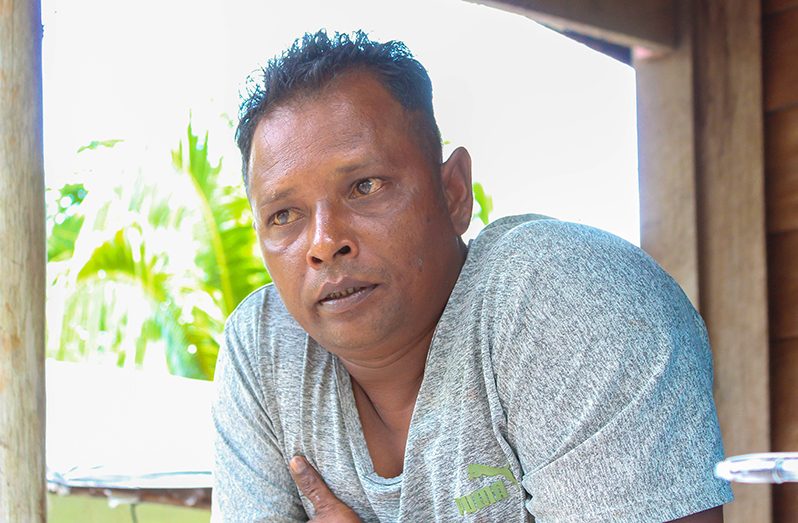How farmers are sowing seeds of hope
AGRICULTURE is a term that has long been used in Guyanese lingo as the driving force behind the development of many villages and the livelihood of countless people across the country. Tigerbone-Banakari is one such community where farming is a part of everyday life in many ways. The captivating aspect of Tigerbone’s agriculture lies in the way its farmers and people go beyond farming.
The people of Tigerbone take traditional agriculture to new and enigmatic heights. Tigerbone’s local economy is built and thrives on agricultural work. Farming and fishing are simply a part of everyday occurrences. From the outside looking in, agriculture may be seen as a difficult, laboured task. But keeping up is not only easy in Tigerbone. It is necessary. Agriculture is hard to ignore in a village encapsulated in nature and greenery. However, with big agriculture comes big problems, such as the farmers of Tigerbone contending with wild animals and the fluctuating price of their produce. The biggest issue of all is, however, the one that they cannot change: the weather.
Among the many places the Pepperpot Magazine has visited, Tigerbone’s natural diversity and beauty certainty stands out. The village is nestled in Long Creek and was named after a small tributary creek named Tigerbone Creek. The village stretches about four miles deep into the dense trees that canopy and frame a dirt trail that makes for a picturesque sight. Tigerbone is one of the places in Guyana that reminds us of the diversity our country has to offer and how similar we all are.

After leaving the streets of Georgetown, the presence of agriculture in Tigerbone is almost overwhelming. One aspect of Tigerbone’s beauty comes from its countless, vast farms. The farms of Tigerbone are unlike any other, as they seem to merge into the natural surroundings. Ground provisions and pineapple are the leading crops that Tigerbone produces. The white sand and clay make for prolific farming in this mix of crops.
The village is home to more than a dozen large-scale farmers, most of whom live in the community. Many of these industrious men and women face the many trials that come with embarking on agriculture. Farm-to-market and the subsequent market prices are just a few of the challenges that farmers face. People like Steven Naraine say that he can work around logistics and even vie for better prices, but he simply cannot fight climate change.
Steven Naraine is one of Tigerbone’s many farmers. Because of its relatively new developments, most of Tigerbone’s population comprises people who have visited the community and decided to stay, enchanted by its charm and eventually deciding to settle down. Steven is one of the many people who came to Tigerbone. Although he does not live in the community permanently, he is a frequent visitor and has one of the village’s largest farms. “I am originally from Hill Foot. But I have always been a part of farming,” said Steven.
He further explained just how much of an intricate role farming has long played in his life. Steven took to agriculture as a young man because of the financial situation his family faced during his youth. As the eldest of his four siblings, Steven realised that he had to find something to make himself somebody, and agriculture was the only thing he knew. After dropping out of high school, Steven turned to agriculture, and he has not left the profession since. He shared that, “I got into farming from the time I got into school, because my parents could not afford to send me to school.”

Steven ventured out into the field with the help of his father. His father was also a farmer, and he gave Steven his first plot of land. Steven later learned that with land and knowledge of farming, he would make a name for himself and provide for his family. “After my father gave me the land, I had a love for it, and I continued,” said Steven.
Throughout the more than two decades that Steven has been into agriculture, he has moved his activities to multiple places, but the most recent has been to Tigerbone. Steven and his crew of farmers occupy more than 40 acres of farm in the backlands of Tigerbone.” The work right now is good but costly,” he shared. The uncertainty of market prices is a challenge that all farmers have. The aspects that Steven, his team and his fellow farmers are finding particularly hard are the water and weather situation.
As Steven explained, throughout his years of farming, the current weather condition is unlike anything he has ever seen. He stated that,“ When the weather is this dry, the eddoes get a fungus on them. If we get water on the land, we could avoid it. This weather happens, but it does not happen in this large amount.” The damaging effects of climate change can be felt and seen.



.png)









